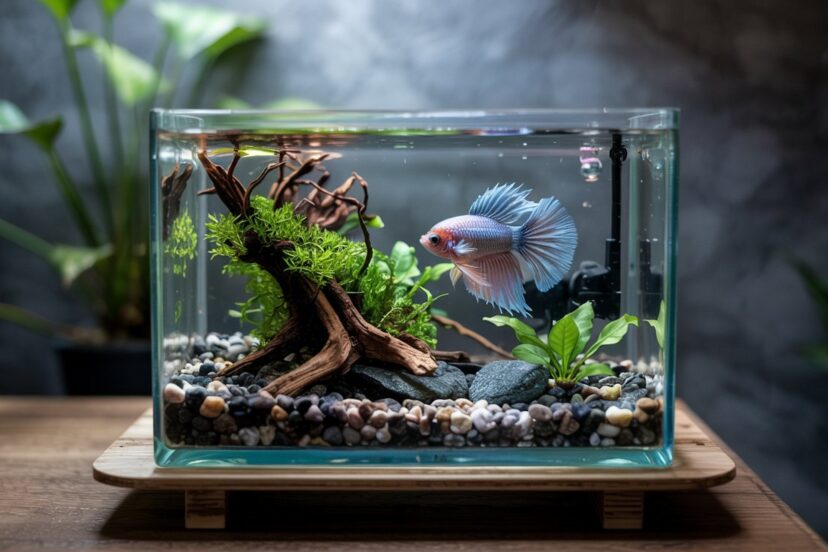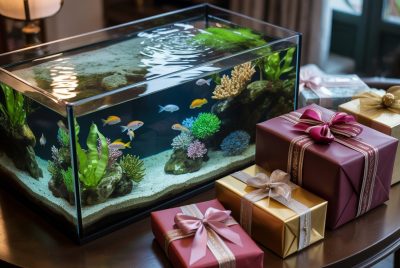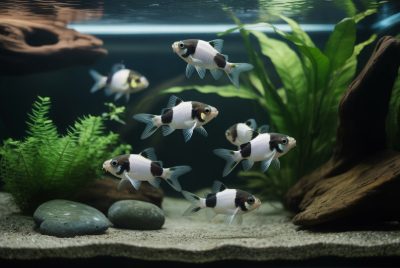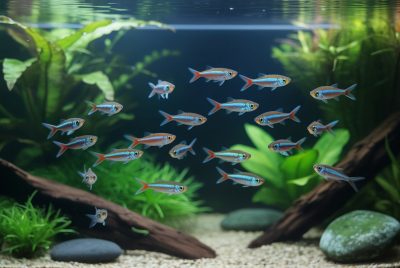Simplicity in Aquatics: The Art of Low-Maintenance Aquarium
*We may earn a commission for purchases made using our links. Please see our disclosure to learn more.
When I first ventured into the world of aquarium keeping, I was overwhelmed by the seemingly endless maintenance routines that experienced aquarists discussed online. Water changes, filter cleaning, plant trimming, algae scrubbing, the list went on. My busy schedule made me question whether I could commit to such demanding care requirements.
That’s when I discovered the art of low-maintenance aquarium keeping. This approach isn’t about cutting corners; it’s about working smarter, not harder. Creating systems that largely sustain themselves while still providing all the beauty and therapeutic benefits of traditional aquariums.
Key Takeaways:
- Low-maintenance aquariums save time while still providing the therapeutic benefits of keeping fish
- Proper planning with suitable equipment, hardy species, and simple aquascaping creates sustainable ecosystems
- Weekly maintenance can be reduced to less than 30 minutes with the right setup
- Automated systems can further reduce the hands-on time required for aquarium care
“The true beauty of an aquarium lies not in its complexity, but in the harmony created between simplicity and nature.”
– David Boruchowitz, Aquarium Magazine
Recommended Low-Maintenance Aquarium Products
Fluval Flex 15 Gallon LED Nano Aquarium Kit
Transform your space with the Fluval Flex 15 Aquarium Kit, a sleek and modern 15-gallon tank designed for both beauty and function. With its eye-catching curved front, customizable LED lighting system, and powerful 3-stage filtration, this aquarium supports vibrant fish and healthy plant growth—making it perfect for beginners and experienced aquarists alike. The included FLEXPad remote allows you to set mood-enhancing lighting effects like lightning storms and cloud cover, while the easy-access top and dual water outputs make daily care a breeze.
- Design: Contemporary curved front and hidden compartments for a clean, stylish look.
- Lighting: Adjustable 7500K white and RGB LEDs promote plant growth and allow creative color combinations.
- Filtration: Powerful 3-stage system ensures crystal-clear water with minimal maintenance.
- Size: May be too small for larger fish species or multiple inhabitants.
- Remote: Some users report the remote control can be unresponsive at times.
- Price: Slightly higher cost compared to basic starter tanks.
All-in-one system with powerful filtration and customizable LED lighting
API FRESHWATER MASTER TEST KIT
Ensure the health and well-being of your aquatic environment with the API Freshwater Master Test Kit. This 800-test kit is perfect for monitoring key water parameters in freshwater aquariums, including pH, ammonia, nitrite, and nitrate. By testing these vital levels, it helps prevent invisible water problems that could harm your fish. Whether you're a beginner or an experienced fish keeper, this easy-to-use kit provides the reliability needed for keeping your aquatic life thriving.
- Comprehensive Testing: Monitors 5 key water parameters for optimal freshwater aquarium health.
- Accurate Results: Includes color card for easy reading of test results.
- Long-Lasting: Provides up to 800 tests for continuous water monitoring over time.
- Freshwater Only: Not suitable for saltwater or reef aquariums.
- Complex for Beginners: Requires careful handling to ensure accurate readings.
- Storage: Must be kept in a cool, dry place to maintain the shelf life of testing solutions.
Essential for monitoring water parameters with minimal effort
Hygger Aquarium Air Stone Kit
Boost the oxygen levels in your aquarium with the hygger Aquarium Air Stone Kit. This 4-inch nano furnace flue round air stone disk set is designed to create small, fine bubbles that promote better water circulation and increase dissolved oxygen for your fish and plants. Perfect for freshwater and saltwater tanks, this air stone ensures a healthy and vibrant aquatic environment. Made from durable aluminum oxide, it’s an essential addition to your aquarium setup, providing long-lasting performance and improving water quality.
- Efficient Oxygenation: Small bubbles provide ultra-high dissolved oxygen for healthier aquatic life.
- Durable Material: Made from high-quality aluminum oxide for long-term reliability.
- Versatile Use: Ideal for both freshwater and saltwater aquariums, as well as hydroponics.
- Power Source: Requires a corded electric air pump for operation.
- Size Limitation: The 4-inch model may be too large for very small tanks or compact setups.
- Noise: Can produce some noise depending on the air pump's power and tank size.
Provides efficient oxygenation with low energy consumption
Seachem Prime Fresh and Saltwater Conditioner
Ensure the health of your aquarium with Seachem Prime Fresh and Saltwater Conditioner, a concentrated formula designed to remove harmful chemicals like chlorine and chloramine while detoxifying ammonia, nitrite, and heavy metals. Perfect for both freshwater and saltwater tanks, this powerful conditioner creates a safe environment for your fish by promoting a balanced and stable ecosystem. Whether you're setting up a new tank or performing water changes, Seachem Prime is an essential tool to keep your aquatic life thriving.
- Effective Detoxifier: Removes chlorine, chloramine, ammonia, nitrite, and heavy metals from tap water.
- Versatile Use: Safe for both freshwater and saltwater tanks.
- Concentrated Formula: A little goes a long way—1 capful treats 50 gallons of water.
- Strong Smell: The concentrated formula may have a strong odor that dissipates once added to water.
- Dose Accuracy: Requires careful measurement to ensure proper dosing for different tank sizes.
- Short-Term Detox: The detoxification of ammonia and nitrite lasts only for 48 hours, requiring biofilter support.
Concentrated formula that detoxifies and conditions tap water efficiently
Why Choose a Low-Maintenance Aquarium?
The allure of watching colorful fish glide through crystal-clear water is undeniable. Aquariums bring nature into our homes, reducing stress and creating focal points in our living spaces. However, the time commitment often deters many potential hobbyists.
Low-maintenance aquariums offer a solution for busy professionals, families with packed schedules, or anyone who wants to enjoy aquatic life without sacrificing hours each week to maintenance. These systems prioritize stability and simplicity without compromising on beauty or the wellbeing of their inhabitants.
I remember my first attempt at keeping fish, a small 10-gallon tank with fancy goldfish that quickly became a water quality nightmare requiring daily attention. After researching and redesigning my approach, I now maintain a thriving 29-gallon ecosystem that needs just 20 minutes of attention per week.
The Foundation: Proper Planning
The secret to a truly low-maintenance aquarium begins long before you add the first drop of water. Planning is everything.
Choosing the Right Tank Size
Counter-intuitively, larger tanks often require less maintenance than smaller ones. A common beginner mistake—one I made myself, is assuming that a small tank means less work. In reality, the larger water volume creates a more stable environment that’s more forgiving of small fluctuations.
“My 5-gallon desktop tank needed water changes twice weekly, while my 40-gallon community tank maintains stability with just one monthly partial water change,” I tell friends who express interest in the hobby.
Aim for at least 20 gallons if space allows. This size provides enough water volume to dilute waste products while still fitting comfortably in most homes.
Efficient Filtration Systems
The heart of any low-maintenance setup is a reliable, oversized filtration system. Investing in quality filtration pays dividends in reduced maintenance time.
I recommend canister filters for tanks over 20 gallons. These powerful workhorses process more water with less cleaning frequency. My Fluval 307 runs for two months between maintenance sessions, compared to the weekly cleaning my previous hang-on-back filter required.
For smaller setups, sponge filters provide biological filtration with minimal moving parts to maintain. They’re nearly impossible to break and create gentle water movement perfect for bettas and shrimp.
Lighting Considerations
Lighting contributes significantly to maintenance requirements, particularly regarding algae growth. Programmable LED lights with adjustable intensity allow you to control the exact amount of light your tank receives.
I learned this lesson the hard way after battling persistent algae in my first tank. By reducing light intensity by 30% and limiting duration to 7 hours daily, algae problems virtually disappeared overnight.
Modern LED fixtures also consume less electricity and generate less heat than older lighting technologies, making them perfect companions for low-maintenance setups.
Selecting Low-Maintenance Inhabitants
Not all aquatic species are created equal when it comes to care requirements. Choosing hardy, adaptable fish and plants dramatically reduces the time you’ll spend addressing health issues or replacing specimens.
Fish Selection
The backbone of any low-maintenance community tank should be hardy species that tolerate a range of water conditions. My personal favorites include:
- White Cloud Mountain Minnows: These active, colorful fish thrive in unheated tanks and have impressive disease resistance.
- Endler’s Livebearers: Smaller cousins of guppies with vibrant colors and adaptability to various water parameters.
- Corydoras Catfish: Perfect bottom dwellers that help clean detritus while adding movement to lower levels of the tank.
- Platies: Peaceful, colorful mid-water swimmers available in countless color variations.
Avoid delicate species like discus or wild-caught specimens that require precise water parameters and frequent feeding. Similarly, messy eaters like goldfish or oscars dramatically increase maintenance requirements.
“The fish you don’t buy determines your maintenance schedule more than the fish you do,” became my mantra after several early mistakes with high-maintenance species.
Plant Selection
Live plants contribute to water quality by absorbing nitrates and providing oxygen, but some require intensive care with fertilizers, CO2 injection, and regular trimming.
For low-maintenance setups, these plant species shine:
- Anubias varieties: Nearly indestructible plants that attach to hardscape and require minimal light.
- Java Fern: Thrives in almost any conditions and propagates slowly.
- Amazon Swords: Once established, these robust plants need little attention beyond occasional root tab fertilization.
- Marimo Moss Balls: Not technically plants but algae that requires virtually no care while adding visual interest.
My first planted tank failed because I selected demanding species requiring high light and supplemental CO2. When I switched to hardier varieties, maintenance time dropped from hours to minutes per week.
Establishing a Self-Sustaining Ecosystem
The closest approach to a maintenance-free aquarium is creating a balanced ecosystem where natural processes handle much of the work.
The Nitrogen Cycle
Understanding and establishing a robust nitrogen cycle is non-negotiable for any aquarium, but especially important for low-maintenance systems. Patient cycling before adding fish ensures beneficial bacteria colonies are ready to process waste.
I spent six weeks cycling my current tank using the fishless method—adding small amounts of ammonia daily and testing until I could confirm the bacteria could process 2ppm of ammonia to nitrates within 24 hours. This patience paid off with a stable system that rarely shows ammonia or nitrite spikes.
The Cleanup Crew
Nature’s janitors can significantly reduce manual cleaning requirements. Consider adding:
- Nerite Snails: Excellent algae eaters that won’t reproduce in freshwater.
- Amano Shrimp: Larger shrimp species that consume algae and leftover food.
- Otocinclus Catfish: Specialized algae eaters for soft green algae.
My cleaning crew consists of five nerite snails and a dozen cherry shrimp. They keep glass and hardscape remarkably clean, reducing my need to scrub surfaces.
Automated Maintenance Systems
Technology offers elegant solutions for reducing manual maintenance:
- Auto-feeders: Dispense precisely measured food portions, even when you’re away.
- Smart power strips: Control lighting and filter schedules automatically.
- Auto top-off systems: Maintain water levels despite evaporation.
After investing in a reliable auto-feeder, I no longer worry about overfeeding (the most common cause of water quality issues) or arranging for someone to feed my fish during short trips.
Streamlined Maintenance Routines
Even the most efficient aquarium requires some maintenance. The key is establishing simple routines that maximize impact with minimal time investment.
Water Change Strategy
Traditional advice often recommends weekly water changes of 25-50%. For low-maintenance systems, consider:
- Larger water changes (40-50%) performed less frequently (bi-weekly or monthly)
- Using a gravel vacuum that simultaneously removes debris while extracting water
- Installing a water change system with valves for quicker draining and filling
I’ve found that a monthly 50% water change using a Python water changer takes just 15 minutes and maintains excellent water quality in my moderately stocked tank.
Cleaning Filtration Media
Resist the urge to clean all filter media simultaneously or too thoroughly. Beneficial bacteria reside in these materials, and excessive cleaning can crash your biological filtration.
My approach:
- Clean mechanical media (sponges, floss) monthly by rinsing in old tank water
- Rotate biological media cleaning, addressing only one-third of materials each time
- Replace chemical media (activated carbon, etc.) according to manufacturer guidelines
This staggered approach maintains biological filtration while keeping water clear and clean.
Algae Management
Prevention is far easier than remediation when it comes to algae. A few preventative measures save hours of scrubbing:
- Limit light duration to 6-8 hours daily
- Position tank away from direct sunlight
- Maintain consistent fertilization if using live plants
- Add fast-growing plants that compete with algae for nutrients
When algae do appear, magnetic scrubbers allow quick cleaning without getting your hands wet. Five minutes twice monthly keeps my glass spotless.
Troubleshooting Common Issues
Even well-designed systems encounter occasional problems. Knowledge of quick fixes keeps these from becoming time-consuming ordeals.
Cloudy Water
Bacterial blooms or fine particulate matter can cloud water temporarily. Rather than panicking with massive water changes:
- Check filter flow to ensure proper circulation
- Add fine polishing pads to filtration temporarily
- Be patient—many bacterial blooms resolve naturally within days
When my tank clouded after adding new driftwood, I simply added a polishing pad to my filter and waited. The water cleared completely within 48 hours with no further intervention.
Sudden Algae Blooms
Occasional algae outbreaks happen even in well-maintained systems. Address them by:
- Temporarily reducing lighting duration by 25%
- Testing for and addressing any nutrient imbalances
- Adding fast-growing floating plants to compete for resources
- Performing one larger water change (50%) to reset conditions
These targeted interventions address root causes rather than just symptoms, preventing recurrence and reducing future maintenance.
Health Issues Among Inhabitants
Even hardy species occasionally develop health problems. Maintaining a small quarantine tank for new arrivals and treatment prevents disease from impacting your main display, saving significant time and stress.
My simple 10-gallon quarantine setup has prevented multiple potential outbreaks from reaching my display tank, each of which would have required extensive treatment and cleaning.
Finding Joy in Simplified Aquarium Keeping
The ultimate goal of a low-maintenance aquarium isn’t just reducing work, it’s increasing enjoyment. When maintenance becomes quick and routine, you spend more time appreciating your underwater world and less time laboring over it.
I’ve found that sitting in front of my tank with a cup of tea, observing the complex behaviors and interactions of my fish community, brings more satisfaction than any high-tech, high-maintenance setup ever did. There’s peace in simplicity.
Low-maintenance doesn’t mean low-quality or boring. My minimalist hardscape with carefully selected plants and fish creates a stunning natural display that guests frequently compliment, never suspecting it requires less than half an hour of maintenance weekly.
Conclusion
Creating a low-maintenance aquarium isn’t about cutting corners—it’s about intelligent design, appropriate species selection, and efficient processes. By investing time in proper setup and planning, you can create an aquatic ecosystem that largely maintains itself while providing all the beauty and tranquility that attract us to the hobby.
Whether you’re a busy professional, a frequent traveler, or simply someone who prefers observation over maintenance, low-maintenance aquarium keeping offers a pathway to enjoying underwater worlds without sacrificing hours each week to their care.
My journey from maintenance-overwhelmed beginner to confident keeper of a largely self-sustaining ecosystem has transformed my relationship with the hobby. I now encourage friends to consider aquarium keeping, confident that with the right approach, they too can enjoy these magical underwater worlds without making maintenance a part-time job.
Frequently Asked Questions
How often do I need to change water in a low-maintenance aquarium?
With proper filtration and stocking levels, water changes can often be reduced to once every 2-4 weeks depending on tank size. Larger tanks (30+ gallons) with moderate fish loads may only require monthly 30-50% water changes while maintaining excellent water quality.
What are the best fish species for beginners wanting a low-maintenance setup?
Hardy species like White Cloud Mountain Minnows, Platies, Corydoras Catfish, and Endler’s Livebearers tolerate a wide range of water conditions and feeding schedules. These fish are colorful, active, and resilient enough to forgive minor maintenance inconsistencies.
Do I need live plants in a low-maintenance aquarium?
While not strictly necessary, easy live plants like Anubias, Java Fern, and Amazon Swords significantly reduce maintenance by absorbing nitrates and competing with algae for nutrients. Choose species that don’t require CO2 injection or extensive fertilization for truly low-maintenance benefits.
How can I reduce algae growth without constant cleaning?
Control lighting duration (6-8 hours daily), avoid placing tanks near windows, maintain appropriate fish-to-plant ratios, and include algae-eating creatures like Nerite snails or Amano shrimp. Using filtration media that removes phosphates can also help prevent algae blooms.
Is a larger tank really easier to maintain than a small one?
Yes, counterintuitively, larger tanks (20+ gallons) are typically easier to maintain because their greater water volume creates more stable parameters. Small fluctuations in waste, temperature, or chemistry are diluted in larger volumes, creating a more forgiving environment that requires less frequent intervention.
















